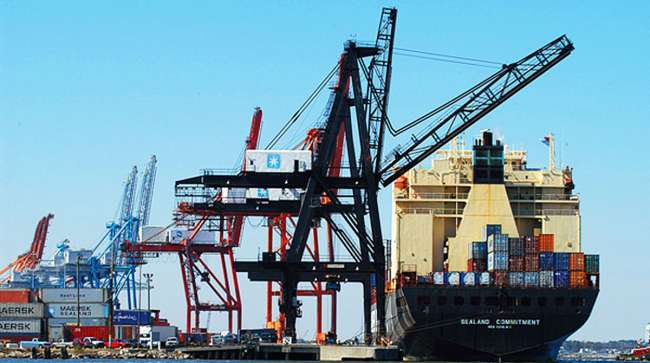Staff Reporter
Federal TIFIA Loan Will Aid Virginia Interstate 64

[Stay on top of transportation news: Get TTNews in your inbox.]
The U.S. Department of Transportation has announced it will provide a loan for up to $502.9 million for infrastructure projects along Interstate 64 in southeastern Virginia, an important corridor that experienced a massive vehicle pileup shortly before Christmas.
Icy conditions on a segment of I-64 near Williamsburg contributed to a chain-reaction crash involving 69 vehicles Dec. 22. Dozens of people were injured.
The Transportation Infrastructure Finance and Innovation Act (TIFIA) loan, announced Dec. 11, will be provided through DOT’s Build America Bureau. Rather than grants, the TIFIA program offers direct loans that support projects related to highways, bridges, intelligent transportation systems, freight facilities and transit.
The Hampton Roads Transportation Accountability Commission will use the loan to help finance Regional Priority Projects along I-64. Hampton Roads is a metropolitan area that encompasses the coastal cities of Virginia Beach, Norfolk and Newport News.

Chao
“This $502.9 million federal investment in transportation infrastructure in the Hampton Roads region will promote economic growth while enhancing safety and mobility for area residents and travelers,” Transportation Secretary Elaine Chao said.
The commission’s Regional Priority Projects, which line I-64, are expected to reduce congestion in the area. The projects include increasing capacity through added lanes and updating portions of highway to current design standards.
This TIFIA loan in particular will support widening portions of I-64 on the Virginia Peninsula, improving the interchange between interstates 64 and 264 east of Norfolk and increasing capacity along I-64 south of Portsmouth, including the stretch of route that traverses the High Rise Bridge.
I-64 is an important east-west freight route in Virginia, running from Hampton Roads through Richmond and Charlottesville and on into West Virginia.
The interstate forms a vital link to Norfolk, which is home to Naval Station Norfolk and Virginia’s major port. The Virginia Port Authority is a nonvoting ex-officio member of the Hampton Roads Transportation Accountability Commission. Its leading exports include mineral fuel, grain, wood and animal feed.
“Anytime upgrades are made to regional roads and interstates, it helps maintain the efficient flow of cargo moving in and out of our terminals, which benefits our customers, the cargo owners and all port users,” Port of Virginia spokesman Joe Harris said.

Page
Kevin Page, executive director of the Hampton Roads Transportation Accountability Commission, said one of the biggest challenges in Hampton Roads is that the area is only served by one interstate — I-64 — and its derivatives. He noted residents are dependent on the interstate because water crossings to traverse the region’s many rivers are limited.
The Hampton Roads Transportation Accountability Commission was established in 2014 to finance and build bridge, highway and tunnel projects. The commission works with the Hampton Roads Transportation Planning Organization, which prioritizes projects and determines how federal funds will be used.
The TIFIA loan will be paid back largely by revenue generated through Virginia’s regional sales and motor vehicle fuel taxes. These taxes were established as part of the Hampton Roads Transportation Fund, which the General Assembly approved in 2013 as a way to sustain infrastructure projects in the area.
According to the Virginia Department of Taxation, the retail sales and use tax is 5.3% statewide. Hampton Roads imposes an additional 0.7% regional tax, resulting in a combined 6% sales tax. Virginia’s excise tax rates are 20.2 cents per gallon on diesel and 16.2 cents per gallon on gasoline, according to the state Department of Motor Vehicles. However, Hampton Roads has an additional regional fuels tax of 2.1%.
“The United States is somewhat strapped for transportation dollars because, as the interstate system came to closure on its development and construction, now we’re challenged as a nation on how we renew our interstate highway system and how we maintain the streets and roads that we’ve built so far,” Page said.

Christopher
The projects supported by the TIFIA loan represent a few of the infrastructure improvements planned for the area. According to Virginia Department of Transportation spokeswoman Holly Christopher, the Hampton Roads area will see more than $1 billion in major projects completed by 2025.
“This work will transform the interstate network in the region,” Christopher said. “New lanes, bridges and flyovers are being added throughout the network that will allow for increased capacity and smoother flow.”
DOT’s Build America Bureau, designed as a “one-stop-shop” for credit opportunities, administers credit and grant programs, provides technical assistance and offers best practices for project planning, financing and delivery.
According to DOT, the agency has issued nearly $6.2 billion in TIFIA assistance during Chao’s tenure. These financings have supported more than $21.2 billion in infrastructure projects. State and local government agencies, private firms and special authorities are eligible to apply.
Want more news? Listen to today's daily briefing:




